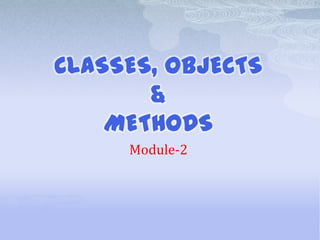
Classes, objects in JAVA
- 1. CLASSES, OBJECTS & METHODS Module-2
- 2. TOPICS TO COVER Introduction. Defining a class. Creating Objects. Accessing Class Members.
- 3. INTRODUCTION Underlying structure of each JAVA programs is CLASSES. CREATE CLASS FIELDS DATA ITEMS basic program OBJECTS METHODS FUNCTIONS Components CREATE OBJECTS METHODS
- 4. DEFINING A CLASS A class is a user-defined data type. Variables and Functions can be created within class SYNTAX EXAMPLE INSATNCE VARIABLES class classname class area { { field declaration; Declaring variables int side; Instance variables are declared int length; exactly as LOCAL variables } method declaration; }
- 5. METHOD DECLARATION Without methods class has NO LIFE. Since objects created by such class cannot respond to any messages. Thus, methods are necessary for MANIPULATING DATA. SYNTAX EXAMPLE class area type method-name(parameter list) { { int side; int length; void get(int s, int l) } { side = s; length = l; Type of the value the method returns. It can be } void, int, float, double }
- 6. EXAMPLE FOR CREATING CLASSES Design a class Account that stores customer name, account number, and type of account. Include necessary methods to achieve following tasks:- Deposit money. Display balance. Permit withdrawal and update balance.
- 7. An object in JAVA is essentially a block of memory that contains space to store all the instance variables. Creating an object also refers to INSTANTIATING AN OBJECT. Objects in JAVA are created using new. The new operator dynamically allocates memory for an object an returns a reference to it. Indicates that it does not point class area null Allocates at run-time to any object { area a1; a1 SYNTAX:- int side; classname objectname; a1 = new area(); int length; objectname = new classname(); void get(int s, int l) combined { a1 side = s; area a1 = new area(); length = l; }
- 8. class area Values are to be assigned to variables in order to use them in { our programs. int side; int length; Since we are outside the class, we cannot access the instance void get(int s, int l) { variables and methods directly. side = s; length = l; Object and dot operator are used to do this. } area a1 = new area(); SYNTAX:- objectname.variablename = value; . a1 side = 10; . objectname.methodname(parameter-list); a1 get (10, 15);
- 11. Constructors Method Overloading Constructor Overloading Nesting of methods
- 12. JAVA allows objects to initialize themselves when they are created CONSTRUCTOR PROPERTIES:- • Initializes an object immediately upon creation. • Same name as the class in which it resides and syntactically similar to a method. • Is called automatically after the object is created. • Does not have return type. EXAMPLE
- 13. NO RETURN TYPE OUTPUT
- 15. Methods have same name, but different parameter list . Is used when objects are required to perform similar tasks but using different input parameters. Also known as POLYMORPHISM. Here, the aim is to provide several method definitions all with same name, but different parameter lists. The difference may either in number or type of arguments Method’s return type does not play any role in this
- 16. In addition to overloading methods, you can also overload constructor method EXAMPLE
- 17. A method of a class can be called only by an object of that class using dot operator. A method can be called by using only its name by another method of the same class NESTING OF METHODS
- 18. STATIC MEMBERS Is used to define a member that is common to all objects and accessed without using a particular object. Thus member belongs to the class as a whole rather than the objects created from the class. Used when we want to have a variable common to all instances of a class. SYNTAX:- static int count; STATIC MEMBERS Referred to as static int max(int x, int y) Class variables and Class methods
- 19. EXAMPLE
- 20. RESTRICTIONS FACED BY STATIC METHODS:- STATIC METHODS ARE CALLED USING CLASS NAME They can only call other static methods. They can only access static data. They cannot refer to this or super in any way.
- 21. USING OBJECTS as PARAMETERS We know how to pass simple types as parameters to methods. It is possible, correct and common to pass OBJECTS to methods. EXAMPLE
- 22. CALL by VALUE vs. CALL by REFERENCE CALL BY VALUE CALL BY REFERANCE This method copies the value In this method, reference to of an argument into the an argument is passed to the formal parameter of the parameter. subroutine Does not access actual This reference is used to argument access the actual argument. Thus, changes made to Thus, changes made to parameter of the subroutine parameter will have an effect have no effect on the on the argument. argument.
- 23. EXAMPLE REMEMBE R CALL by VALUE:- Simple type arguments are passed to methods. CALL by REFERENCE:- Objects are passed to methods
- 24. RECURSION JAVA supports recursion. Recursion is the process of defining something in terms of itself. A method that calls itself is said to be recursive.
- 25. VISIBILITY CONTROL Visibility modifiers areused to restrict the access to certain variables and methods from outside the class. Also known as ACCESS MODIFIERS. Visibility Labels PUBLIC PROTECTED PRIVATE
- 26. VISIBILITY CONTROL (Contd..) PUBLIC Visible to entire class in which it is defined and All the class Outside PRIVATE Enjoys highest degree of protection. Accessible only with their own class. Cannot be inherited, thus not accessible in sub-class. Friendly When no access modifier is specified then the default version of public accessibility is known as “FRIENDLY” PUBLIC PROTECTED ItsFriendly between PUBLIC ACCESS & FRIENDLY level lies ACCESS. Makes fields visible in all Makes the fields visibleonly only to all classes and Makes fields visible not in classes, regardless of their subclasses in same package but also to subclasses in the same package. packages other packages
